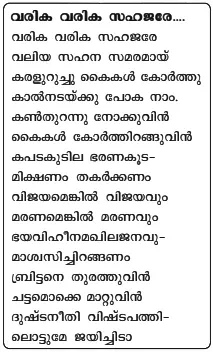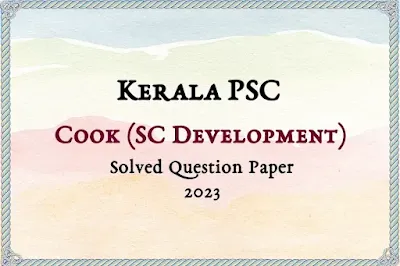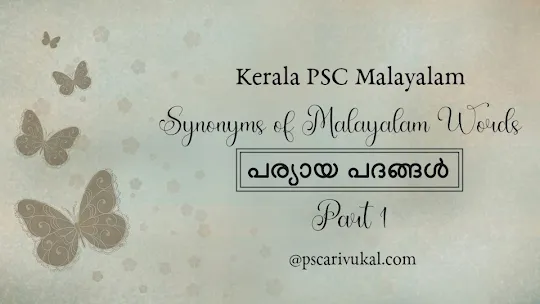A
s we already learned the Salt Satyagraha was one of the most significant events in the history of the Indian freedom struggle led by Mahatma Gandhi. Parallel to that, similar events of salt satyagraha also took place in Kerala in 1930.The salt satyagraha in Kerala was held under the leadership of Kerala Gandhi, K. Kelappan. Even though Beypur and Payyannur were the two major places where Salt Satyagraha took place in Kerala, Satyagrahis from different parts of Kerala took part in this struggle.
In this segment, we'll learn more about the Salt Satyagraha movements that occurred in Kerala, particularly that of Payyannur for various PSC exams.
Basic Facts
- Started on – April 13, 1930.
- Salt Satyagraha Centers in Kerala – Payyanur & Beypore.
- Main Venue of Salt Satyagraha in Kerala – Uliyathu Kadavu, Payyanur.
- Second Bardoli – Payyanur.
- Leader of the Salt Satyagraha in Kerala – K. Kelappan.
- Other notable Leaders –
- P. Krishnapillai,
- E. Moidu Moulavi,
- Moyarath Sankaran,
- P. Keshavan Nambiar,
- K. Kunjambu Nambiar,
- Muhammad Abdur Rahman Sahib.
- The Salt March started under the leadership of K. Kelappan on – April 13, 1930 (Kozhikode).
- Song sung during Salt Satyagraha March in Kerala – 'വരിക വരിക സഹജരെ...'
- Written by – Amshi Narayana Pillai.
- No. of volunteers participated in the Salt Satyagraha with Kelappan – 32.
- The people of Travancore who participated in the Salt Satyagraha of Malabar –
- P. Krishnapillai,
- K. Kumar,
- N.P Kurukkaḷ,
- Ponnara Sridhar.
- The Salt March ended at Payyanoor on – April 21, 1930.
- K. Kelappan violated the Salt Act on – April 23, 1930.
- Leader of Salt Satyagraha after the arrest of Kelappan – Moyarath Sankaran.
- 'Pilot of Salt Satyagraha in Kerala' – Moyarath Sankaran.
- After the arrest of K. Kelappan, the venue of Salt Satyagraha in Kerala was shifted to – Kozhikode.
- Second Main Venue of Salt Satyagraha in Kerala – Kozhikode.
- Leaders of the Salt Satyagraha in Beypore (Kozhikode) – Muhammad Abdu Rahiman & P. Krishnapillai.
- Leader of the Salt Satyagraha march from Palakkad to Payyanur – T.R. Krishnaswamy Iyer.
- Salt Satyagraha in Kerala was suppressed by the police on – May 12, 1930.
- Approx. no. of people who were jailed in connection with the salt march in Kerala – 500.
- The freedom fighter who died on a hunger strike following the Salt Satyagraha – Kunjhiraman Adiyodi (Bellari jail).
- How many days did Kunjhiraman Adiyodi fast for before attaining death – 43 days.
- The freedom fighter who lost his eyesight during a Police lathi charge in the Salt Satyagraha – Kurur Neelakanthan Namboodiripad.
- Name the Salt Satyagraha leader who became known as 'Keralayeen' – K. Kunjambu Nambiar.
- Salt Satyagraha Memorial in Kerala is located at – Uliyath Kadavu (Payyannur).
- The Malayalam Newspaper that became a daily on the occasion of Salt Satyagraha – Mathrubhumi.
Salt Satyagraha in Payyannur
On March 9, 1930, the KPCC (Kerala Pradesh Congress Committee) meeting at the Kerala Kesari newspaper office in Vadakara granted approval for the Satyagraha as a part of the civil disobedience movement and chose Payyannur Salt as the Satyagraha venue and K. Kelappan as the leader.
There were three batches of 32 volunteers that marched from Kozhikode to Payyanur on April 13, 1930, under the leadership of K. Kelappan (33 if you include K. Kelappan).
The general captain was K.T. Kunhiraman Nambiar and the batch leaders were P. Krishna Pillai, P. Kesavan Nambiar, and M.N. Pisharaody. The 15-year-old boy K. Madhavan (ബാലനായ സത്യാഗ്രഹി) was the youngest agitator in the march.
Kurur Neelakandan Namboothiripad addressed the gathering on April 21, 1930, when they were on their way to Payyannur.
Moyarat, Kunhishankara Menon, P. Kumaran, and C.H. Govindan also led the greeting on their way. The procession arrived in Payyannur on April 22nd and was welcomed by A.K. Gopalan.
The procession arrived in Uliathukadavu the next day. K. Kelappan breached the law in an environment of slogan chants and national songs on April 23. As a result, Uliathukadavu became the epicenter in the history of Kerala's independence struggle.
There, K. Kelappan gathered salty sand with coconut shells in gunny bags, distilled it, and then sold it at an auction near the old police station in the evening for an incredible price of Rs. 25 per piece.
The vastitude of the police station became the venue of a public demonstration and the burning of foreign apparel, picketing liquor shops, and propagation of Khadi were conducted as a part of this.
A two-day strike was conducted in support of auctions. The cops began using lathis on the third day.
Thrikaripur saw the first arrest linked to the Payyannoor Satyagraha. K. Kelappan, who broke the salt law and sold the salt, was arrested, as was C.M. Kunhiraman Nair, who bought the salt from K. Kelappan.
Following K. Kelappan's arrest, it was Moiyarat Sankaran who led the Salt Satyagraha thereafter.
Moiyarat, T. Subramanian Thirumump, P.C.K. Adiyodi, A. Lakshmana Shenoi, Makuni Sankaran Nambiar, Vishnu Bharatiyaan, and others were eventually caught and imprisoned for six months.
Payyanur was dubbed the "Second Bardoli" in recognition of its valor and sacrifice during the Salt Satyagraha.
The Salt Satyagraha Memorial is located near Payyannur in Uliathukadav.
Salt Satyagraha in Palakkad
Meanwhile, T.R. Krishnaswami Iyer organized a second party of volunteers from Palakkad to Payyannur at the request of the Satyagraha Committee.
Their jatha started off on April 19 from Sabari Ashram at Olavakkode, near Palakkad, led by R.V. Sharma. They were cheered on by the crowd and were garlanded along the way by K.P. Kesavamenon.
Salt Satyagraha in Kozhikode
The first instance of salt satyagraha of Beypore, Kozhikode on May 12, 1930. Under the supervision of Muhammad Abdu Rahiman, K. Kelappan, Madhavanar, Sharma, and P. Krishna Pillai violated the salt law.
Around forty volunteers returned to the Kozhikode beach at five o'clock in the morning for breaching the salt law. The demonstrators were kicked with boots and mercilessly beaten with lathis by police officers led by Asst. Superintendent Amu and Sub-Inspector Kunhiraman Nair.
At the moment, Krishna Pillai and Sharma were struggling to reclaim the national flag from the police. Finally, the flag was captured by Krishnapillai and the flag stick was seized by Sharma. Despite the best efforts of the authorities, they did not give up.
Finally, both of them including all others were arrested by the police, and Muhammad Abdu Rahiman was jailed for 9 months. However, these occurrences did not damper the spirits of the demonstrators.
Another salt harvesting strike took place on the Kozhikode quayside on February 2, 1931. Eswariyammal, T.R. Krishnaswamy Iyer's wife, led six individuals detained on the day of the strike.
In short, Leaders of Salt March in Kerala
| Venue | Leaders |
|---|---|
| Payyanur | K. Kelappan |
| Palakkad | T.R. Krishnaswamy Iyer |
| Beypore (Kozhikode) | Muhammad Abdu Rahiman |
| Ponnani (Malappuram) | E. Moidu Maulavi |
***Update: Sorry, I couldn't find anything more on Kannur, Kumarji, and his involvement in Salt Satyagraha other than that mentioned in the comment section and Wikipedia links. But I'll keep on searching and will update the section if anything happens in the future.
📝SideNotes:
- Kerala Subhash Chandrabose – Muhammad Abdu Rahiman.
- A song sung by Gandhiji and his followers on the occasion of Salt Satyagraha – Raghupati Raghava Rajaram.
- Malayalees who accompanied Gandhi on Dandi March – 5.
- Thappan Nair (from Tamil Nadu), C. Krishnan Nair, Titus, Raghava Pothuwal, Shankarji.
- The Salt Satyagraha in Tamil Nadu was led by – C. Rajagopalachari.
- Vedaranyam Gandhi – C. Rajagopalachari.
- Beypore Gandhi – Muhammad Abdu Rahiman.
- Name the Malayali who participated in the Salt Satyagraha in Tamil Nadu under the leadership of C. Rajagopalachari – G. Ramachandran.
- T.R. Krishnaswami Iyer was also known as – Untouchable Brahmin.
- Founder of Sabari Ashram – T.R. Krishnaswami Iyer.
- The only place which was visited thrice ( (1925, 1927, 1934) by Mahatma Gandhi in Kerala.
- Name the renaissance hero who is known by the pen name 'Keraliyaan' – Swadeshabhimani Ramakrishna Pillai.
- What was the other marching song of Kerala Salt March written by P. Krishna Pillai? Vazhuka Vazhuka Bharathasamudayam (വാഴുക വാഴുക ഭാരത സമുദായം).*
- The newspaper published by Muhammad Abdu Rahiman – Al-Ameen.
- published from Calicut during 1924–1939.
- Founder & editor – Muhammad Abdu Rahiman.
- Autobiography of K. Madhavan – Payaswiniyude Theerangalil (പയസ്വിനിയുടെ തീരങ്ങളിൽ)











6 Comments
Kannur was a major site of Salt Satyagraha but is being ignored altogether. There, it was led by K. Kumar (known popularly as Kumarji) whom you mention as an activist from Travancore in your article. You may find limited details of this in Wikipedia (History of Kannur: Section on Salt Satyagraha and Civil Disobedience Movement). Limited details are available also in Moyyarathu Sankaran's Athmakatha (Page 60) and Kaviyur Rajagopalan's Swatantryathinte Aakasam (Pages 67 and 68). K. Kumar was also an eloquent speaker who exerted a highly influential role on the Civil Disobedience Movement of Malabar, a fact bearing testimony in many old records including Perunna KN Nair's Keralathile Congress Prasthanam (Prathibha Publishers 1967, Page 60)
ReplyDeleteബാലനായ മാധവന്റെ auto ബയോഗ്രാഫി ആണോ പയസ്വിനിയുടെ.......
DeleteYes. Reference: https://en.wikipedia.org/wiki/K._Madhavan#:~:text=Biography,Kelappan.
DeleteKerala psc oriented ആയിട്ടാണ് article എഴുതിയത്. Kumarjiയും ഉപ്പു സത്യാഗ്രഹവുമായി ബന്ധപ്പെട്ട PSC ചോദ്യങ്ങൾ ഇതുവരെ refer ചെയ്ത question papersil കണ്ടിട്ടില്ല.
ReplyDeleteThank you very much for the info. Kumarji & സത്യാഗ്രഹത്തെക്കുറിച്ചു കൂടുതൽ refer ചെയ്തിട്ട് post അപ്ഡേറ്റ് ചെയ്യാം. Thanks.
Great! TQ
ReplyDeleteMany references on the Salt Satyagraha of Kannur (and Kumarji) have seemingly not survived and are therefore rare. Yet, you may refer to: (1) the autobiography of Moyyarathu Sankaran (Atmakatha: Page : 164),
ReplyDelete(2) Autobiography of NC Shekhar (Agniveedhikal) multiple pages,
(3) Swatanthryathinte Akasam, Kaviyoor Rajagopalan, Chapter 18 (Kannoorinte Chirakil) ;
(4) A Sreedhara Menon : Keralavum Swatantrya Samaravum: 13th Edition, Page 85;
(5) Keralathile Congress Prasthanam, Perunna KN Nair (1967?), Page 60
(6) Sarva Vijnana Kosam (brief article on Kumar K) and so on...
Post a Comment